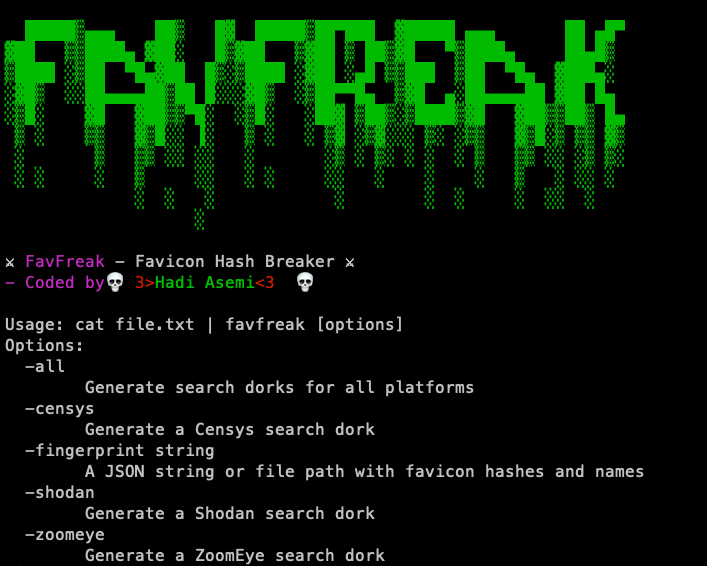FavFreak is a tool designed to help bug bounty hunters identify websites using the same favicon across different domains. By generating unique hashes from favicons, you can uncover hidden infrastructure, find shadow IT assets, and increase your chances of discovering vulnerable services.
This tool supports search engines like Shodan, ZoomEye, and Censys to help you quickly and efficiently discover similar systems across the internet.
The original concept and Python implementation were created by Devansh Batham, which inspired the development of this improved version in Go. In this version, we’ve enhanced performance and added additional features like integrated search dork generation for multiple platforms, making it a more efficient tool for bug bounty hunters and cybersecurity researchers.
- Generate Favicon Hashes using MMH3 and MD5 algorithms.
- Search Across Platforms like Shodan, ZoomEye, and Censys using generated hashes.
- Detect Shared Infrastructure based on the same favicon hash across multiple domains.
- Identify Shadow IT Assets by detecting systems not directly linked from public sites.
- Fingerprint-Based Detection of technologies or services using favicon hashes.
favfreak is written in Go, so you'll need to install it first. Here’s how to install Go on your system:
sudo apt update
sudo apt install golang-gobrew install goDownload the installer from the official Go website.
Verify the Go installation:
go versiongo install github.com/Hadiasemi/favfreak@latestTo generate the favicon hash for a target website, run the following command:
cat file.txt | favfreakThe tool will attempt to fetch the favicon from the target, calculate its MMH3 and MD5 hashes, and display the results.
favfreak can generate search dorks that you can directly use on Shodan, ZoomEye, and Censys to find other systems using the same favicon hash.
To generate dorks, run the following:
cat file.txt | favfreak -shodancat file.txt | favfreak -zoomeyecat file.txt | favfreak -censys cat file.txt | favfreak -allOne of the core features of favfreak is the ability to match favicon hashes to known services or technologies using a fingerprint dictionary.
{
"99395752": "slack-instance",
"878647854": "atlasian"
}You can run favfreak with a fingerprint file to detect known services:
favfreak -fingerprint fingerprints.jsonThis will show results like:
================= [FingerPrint Based Detection Results] =================
[slack-instance] - count: 1
[atlasian] - count: 2
You can also pass the fingerprint as a JSON string directly in the terminal:
favfreak -fingerprint '{"99395752": "slack-instance", "878647854": "atlasian"}'Many companies use the same favicon across multiple domains. By identifying domains with the same favicon hash, you can map out a company's infrastructure, uncover hidden assets, and find more entry points for vulnerabilities.
By using Shodan, ZoomEye, or Censys, you can identify services that may not be directly linked to the public-facing website. These shadow IT assets are often forgotten and more vulnerable.
Some favicons are tied to specific services or technologies. Using the fingerprint dictionary feature in favfreak, you can quickly identify services like Slack, Atlassian, or F5 Big-IP based on their favicon hashes.
-
Identify Favicon Hash: Start by generating a favicon hash for the target website using favfreak:
cat file.txt | favfreak -
Search Across Platforms: Use the generated dorks to search Shodan, ZoomEye, and Censys for other domains or IP addresses that use the same favicon:
cat file.txt | favfreak -all -
Map Out Infrastructure: If you find other domains or IPs using the same favicon, investigate these targets as part of your bug bounty assessment. These services might be part of the company's infrastructure but are often overlooked or misconfigured.
-
Leverage Fingerprint-Based Detection: If you have known hashes for specific technologies or services, you can use the fingerprint-based detection feature to quickly identify them:
cat file.txt | favfreak -fingerprint fingerprints.json
If you’d like to contribute to favfreak, feel free to submit a pull request or create an issue in the repository.
